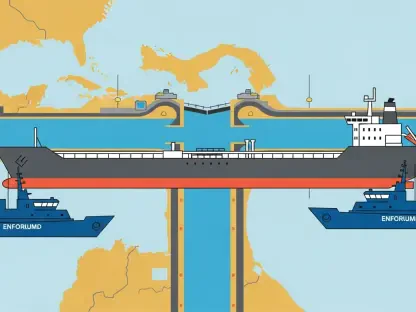In a world grappling with the urgent need to curb carbon emissions, the transportation sector stands as one of the most significant contributors to environmental degradation, yet it also holds immense potential for transformative change. Imagine a bustling city like Stockholm, where commuters glide over water on a ferry that produces almost no emissions, slashing energy use while offering a swift, comfortable ride. This is no longer a distant dream but a reality with the introduction of a groundbreaking innovation from Sweden. The electric hydrofoil ferry, known as the Candela P-12 Nova, has emerged as a symbol of sustainable transport, seamlessly integrating into Stockholm’s public system. As global attention shifts toward alternative energy solutions, this development highlights how technology can address both environmental challenges and urban mobility needs, paving the way for a cleaner future.
Pioneering Sustainable Transportation
Breaking Ground with Electric Hydrofoil Technology
The transportation industry is undergoing a profound shift as it seeks to move away from fossil fuels, and Sweden is at the forefront of this revolution with the Candela P-12 Nova. This electric hydrofoil ferry, recently integrated into Stockholm’s public transit network, represents a remarkable advancement in waterborne travel. Unlike traditional diesel ferries that contribute heavily to carbon emissions, Nova leverages cutting-edge hydrofoil technology to lift itself above the water, reducing drag and achieving an impressive 95% reduction in emissions. Additionally, it boasts an 84% decrease in energy consumption per passenger-kilometer, making it a highly efficient alternative. This innovation not only addresses environmental concerns but also enhances accessibility across Stockholm’s islands, offering a practical solution for urban commuters who might otherwise rely on private vehicles for their daily travel needs.
Beyond its technical achievements, the Candela P-12 Nova serves as a catalyst for changing commuter behavior in densely populated urban areas. By providing a fast and comfortable mode of transport, it encourages individuals to opt for public waterborne options over road-based alternatives, thereby reducing traffic congestion and associated pollution. Gustav Hasselskog, the CEO and founder of Candela, has emphasized the importance of such innovations in demonstrating that sustainable transport can be both convenient and appealing. This shift in perspective is crucial for cities aiming to meet stringent emissions targets while maintaining efficient mobility systems. As more commuters experience the benefits of this technology, the potential for broader adoption across other regions becomes increasingly viable, marking a significant step toward a more sustainable urban transport landscape.
Competing Solutions in the Energy Transition
While the electric hydrofoil ferry marks a significant milestone, it exists within a broader landscape of competing technologies vying to redefine sustainable transportation. Electric vehicles, particularly hybrid-electric models, have gained substantial traction in the passenger car market, driven by advancements in battery technology and widespread consumer adoption. However, limitations in battery capacity and longevity pose challenges for sectors like aviation and heavy-duty transport, where electric solutions are less feasible. This gap has allowed hydrogen fuel-cell technology to emerge as a complementary option, offering promise for long-range and high-energy-demand applications. The diversity of approaches underscores the industry’s recognition that no single solution can address all needs, pushing for a multifaceted strategy to achieve carbon neutrality.
Another critical aspect of this energy transition is the role of infrastructure and policy support in scaling these technologies. Scandinavian countries, with Sweden leading the way, have set a high standard by actively investing in sustainable transport initiatives. Government backing, alongside collaboration with industry stakeholders and innovative startups, is essential for overcoming practical hurdles such as building charging networks or hydrogen refueling stations. The success of projects like the Nova ferry illustrates how localized solutions can inspire global change, provided there is a commitment to systemic improvements. As alternative technologies continue to evolve, the competition between electric, hydrogen, and other emerging options will likely drive further innovation, ensuring that the transportation sector remains dynamic and responsive to environmental imperatives.
Shaping the Future of Urban Mobility
Systemic Change Beyond Technology
The introduction of the Candela P-12 Nova is more than a technological triumph; it reflects the necessity for systemic change to support sustainable transport on a larger scale. While innovations like electric hydrofoils offer impressive environmental benefits, their widespread adoption hinges on the development of supporting infrastructure and robust policy frameworks. In Sweden, policymakers have prioritized investments in green transport, creating an ecosystem where new technologies can thrive. This includes not only funding for research and development but also incentives for public adoption, such as subsidies for eco-friendly commuting options. Such measures are vital for ensuring that advancements like Nova are not isolated successes but part of a broader movement toward sustainability in urban mobility.
Equally important is the collaboration between various stakeholders, including governments, private companies, and local communities, to address the challenges of implementing these technologies. Scaling up solutions requires overcoming logistical barriers, such as integrating new transport modes into existing networks and ensuring affordability for users. The experience in Stockholm demonstrates how targeted efforts can yield significant results, with the ferry enhancing connectivity between islands while reducing reliance on carbon-intensive alternatives. As other cities look to emulate this model, the emphasis must remain on tailoring solutions to local needs while maintaining a commitment to environmental goals. This holistic approach ensures that the benefits of sustainable transport are felt across diverse urban landscapes, fostering a global shift in how mobility is perceived and managed.
A Vision for Collaborative Progress
Looking back, the journey of the Candela P-12 Nova showcased how a single innovation could spark widespread inspiration in the transportation sector. Its integration into Stockholm’s public system proved that eco-friendly solutions could be both practical and impactful, setting a precedent for other cities to follow. The remarkable reductions in emissions and energy use achieved by this electric hydrofoil ferry highlighted what was possible when technology aligned with environmental priorities. Reflecting on this milestone, it became evident that the path to sustainability was paved with bold ideas and persistent efforts to overcome initial obstacles.
Moving forward, the focus should shift to fostering international collaboration and knowledge-sharing to replicate such successes on a global scale. Governments and industries must prioritize investments in diverse technologies, ensuring that solutions like electric hydrofoils, hydrogen systems, and beyond are explored and refined. Encouraging pilot programs in varied urban settings can provide valuable insights into scalability and adaptation. Additionally, engaging communities to build trust in these new systems will be key to driving adoption. As the transportation landscape continues to evolve, a unified commitment to innovation and sustainability can transform challenges into opportunities for a cleaner, more connected world.









